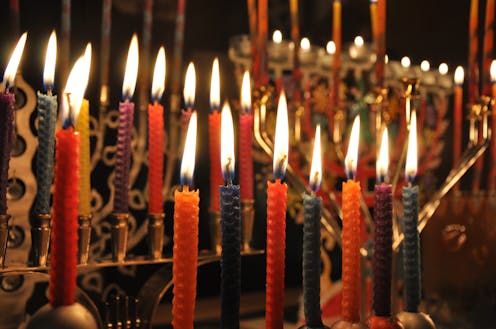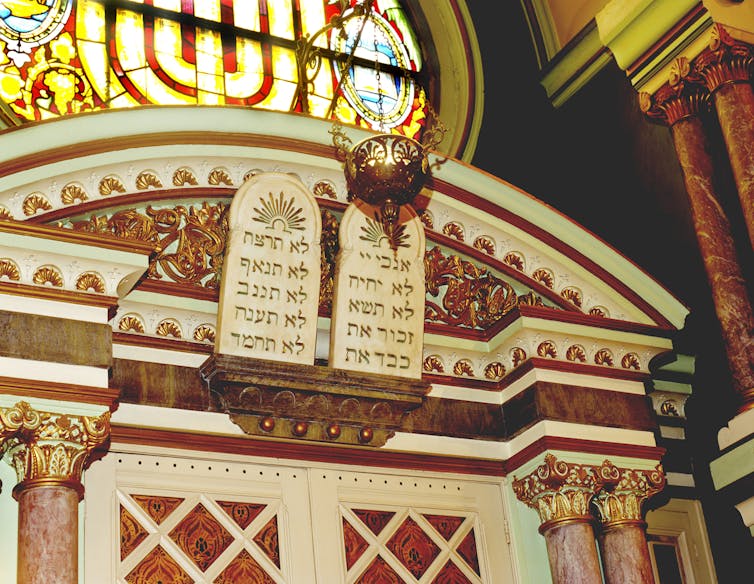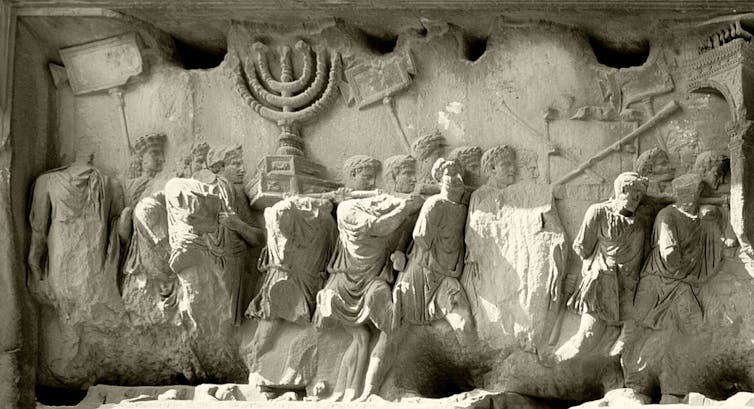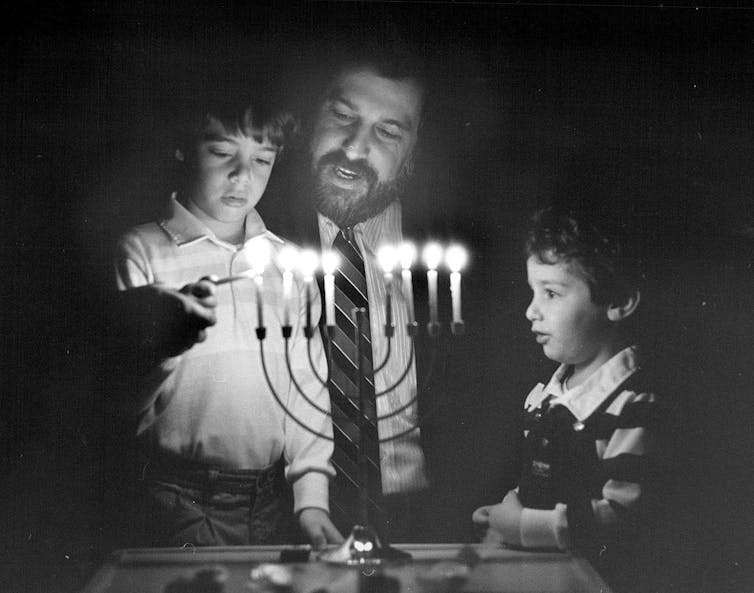At Hanukkah, a celebration of eternal light − from the desert tabernacle to synagogues today
The Hanukkah story centers on rekindling the eternal light in the Temple, a symbol of God’s presence. Similarly, the Ner Tamid above the ark in synagogues is never supposed to go out.

My earliest religious memory is of our synagogue’s Ner Tamid: the decorative electric lamp that hangs in every sanctuary, above the ark holding the Torah scrolls.
This lamp, I learned from parents and teachers, was an eternal light – the literal meaning of the Hebrew term Ner Tamid. This meant it had to remain lit continuously. It could never go out.
I’m not certain that, at 7 years old, I quite understood what this lamp symbolized. But I do know that the idea of its being “eternal” concerned me. I was troubled by what my personal experience had taught me about light bulbs: They burn out.

If this lamp needed to be eternal – and if, as I eventually surmised, it had something to do with God – then what terrible thing would happen when it burned out? Or if the power went out in a storm?
These thoughts disturbed me. It was as though everything the synagogue meant to me as a child hung upon a light fixture, the Ner Tamid and the small amount of illumination it offered.
Divine presence
When I grew up, I became a professor of Jewish studies. I now know that the Ner Tamid that so fascinated me as a child memorializes the seven-branched candelabra in the biblical tabernacle. The Torah describes the tabernacle as a portable sanctuary, a place of worship during the ancient Jews’ 40 years of wandering through the wilderness after God brought them out from slavery in Egypt.
According to the books of Exodus and Leviticus, this candelabra, fueled with pure olive oil, was to burn from evening until morning throughout the generations. Since the tabernacle was built to be God’s dwelling place, the candelabra’s light marked God’s presence among the Jewish people.
In later Jewish history, that candelabra became the model for lamps that continuously burned in the First and Second Temples in Jerusalem – the center of the Israelites’ worship. The first stood from the time of King Solomon in the 10th century B.C.E. until Jerusalem was conquered by Babylonian armies 400 years later. The second was built around 500 B.C.E. and demolished during the Roman destruction of Jerusalem in 70 C.E.
Appearing in Jewish art from antiquity until today, this ever-burning, seven-branched candelabra symbolized the permanence of the people of Israel’s connection to God, and God’s continual presence among the Jewish people. And so it is with the Ner Tamid in synagogues today.
Roots of Hanukkah
Each year during Hanukkah, I reflect on my youthful trepidation that my synagogue’s Ner Tamid might go out. For Hanukkah recalls an occasion on which, in the second century B.C.E., that is exactly what happened.
At the time, King Antiochus IV of Syria ruled over the Seleucid Empire, which governed much of the Mediterranean and Middle East, including Judea. In 168 B.C.E., the empire forbade Jewish practices, hoping to forcibly assimilate the Jews into Greek culture, and desecrated the Jewish Temple in Jerusalem – extinguishing the candelabra, or menorah.

Considering my childhood anxiety over the Ner Tamid’s going out even briefly, I can hardly imagine the pain of this persecution. Alongside the physical abuses that Jews suffered, the loss of the eternal light must have suggested that God’s presence no longer abided in the Temple or among the Jewish people. I can think of nothing more terrifying.
A ragtag army of Jews revolted, led by the Maccabees, a family of pious Jewish priests. They defeated the much more powerful Seleucid army and recaptured Jerusalem, including the Temple. Inside, according to tradition, they found pure lamp oil sufficient to rekindle the menorah for only one day. Miraculously, that small amount of oil lasted eight days, time enough for additional oil to be prepared.
Keep the light alive
Hanukkah teaches a lesson of hope and resilience – of the need, indeed, of the responsibility, to fight for the human freedoms that are all people’s right.
At the same time, the holiday’s central symbol is not a sword but a candelabra. This one holds nine candles, one of which is used to light the other eight – representing each day of the miracle. Each night of Hanukkah, Jews light this hanukkiah, as a nine-branched menorah is called, beginning with one candle and adding a candle each night until the entire candelabra is ablaze.

Ideas about God’s saving power stand deep within the Hanukkah story. But I like to focus on a different kind of miracle that I see here.
The Maccabees initiated their fight against all odds. Similarly, those who lit the little bit of oil they found in the Temple rubble elected hope over despair. In this, I see the holiday’s most enduring message: When people set their minds to it, when we choose to act, we accomplish that which might appear impossible.
The creation of a more perfect world, the kind of world we want to bequeath to coming generations, will indeed be a miracle – but one we must undertake to achieve.
And I now have an answer to my childhood concern that my synagogue’s eternal light might go out. If it does, I know that it is up to me to relight it.
Alan Avery-Peck does not work for, consult, own shares in or receive funding from any company or organization that would benefit from this article, and has disclosed no relevant affiliations beyond their academic appointment.
Read These Next
West Antarctica’s history of rapid melting foretells sudden shifts in continent’s ‘catastrophic’ geo
A picture of what West Antarctica looked like when its ice sheet melted in the past can offer insight…
How the ‘slayer rule’ might play a role in determining who will inherit wealth from Rob Reiner and h
These rules have a long history in the United States. They played a role in the notorious murders by…
The celibate, dancing Shakers were once seen as a threat to society – 250 years later, they’re part
‘The Testament of Ann Lee,’ Mona Fastvold’s 2025 film, depicts part of the long history of Shaker…






